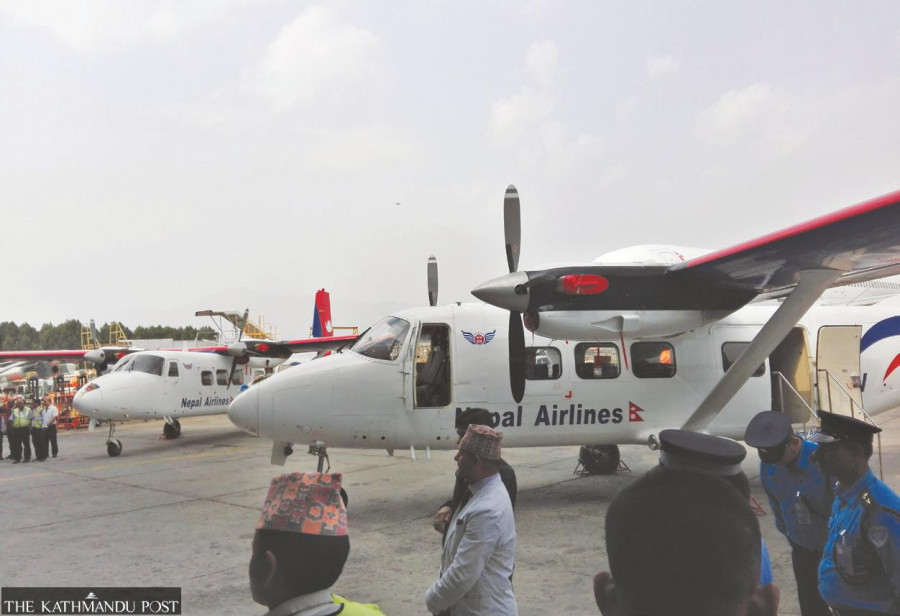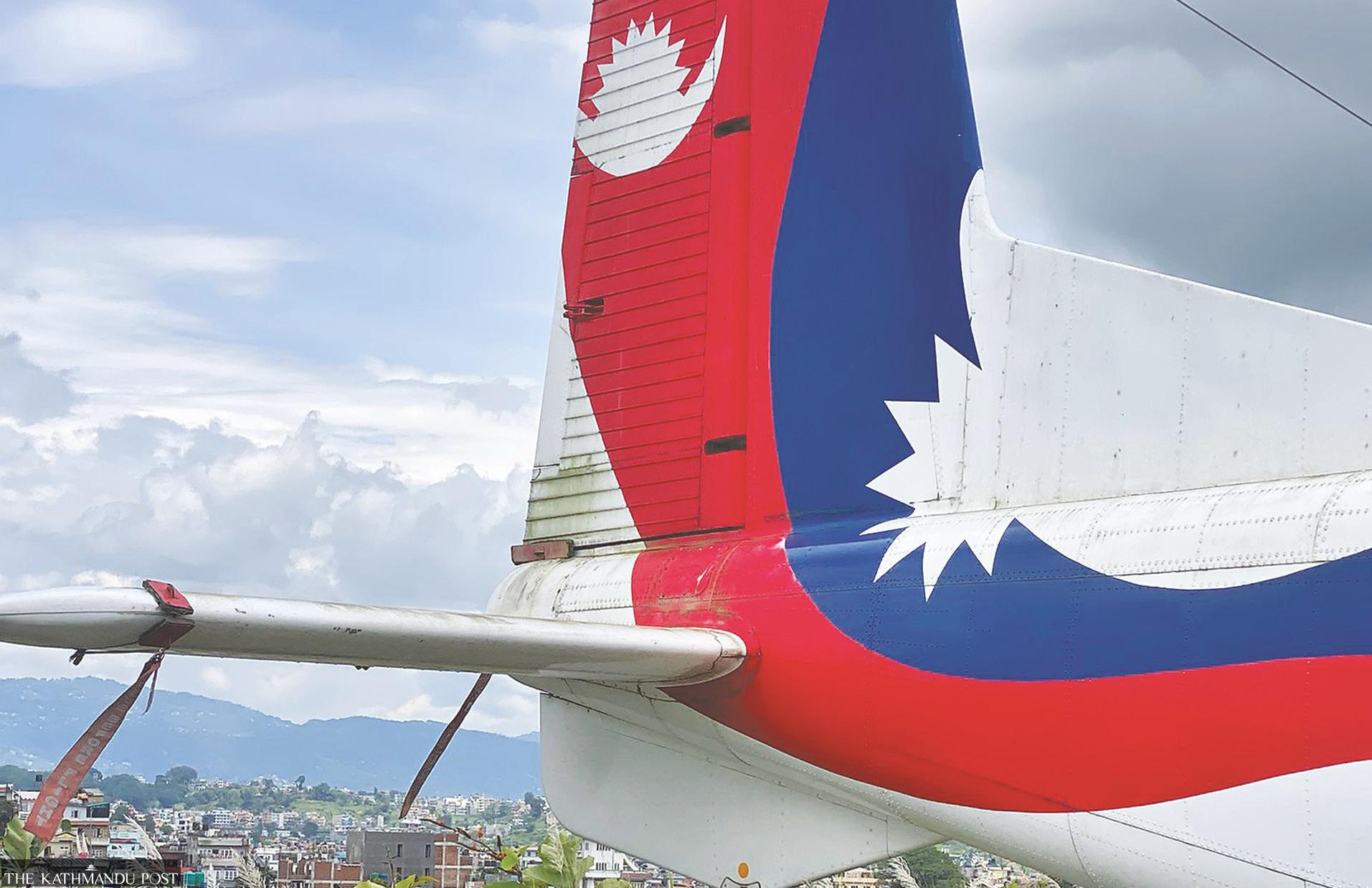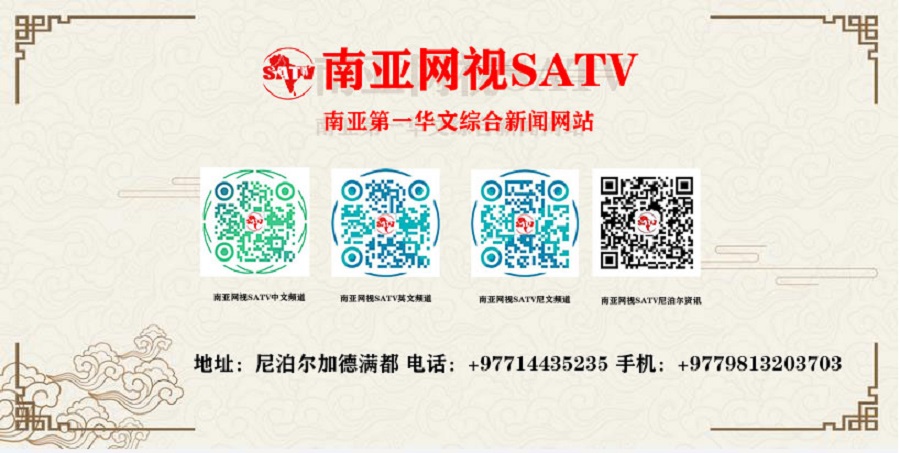
A batch of Chinese aircraft that Nepal had imported with high hopes of flying on unserved sectors and earning revenue for the ailing Nepal Airlines Corporation have been sitting on the ground for more than two years and gathering rust, just as the Ministry of Finance has started paying back interest on the loans for the planes.
For the national flag carrier which has a hard time balancing its books even in the best of times, the jinxed planes have been like something stuck in its throat that it cannot spit out or swallow, to use a local idiom.
The Chinese planes, the first of which arrived in 2014, cost more money to operate than they brought in, and Nepal Airlines was racking up losses dangerously. In July 2020, the corporation's board had had enough, and decided to put them in deep storage.
The five condemned planes—three 17-seater Y12e aircraft and two 56-seater MA60 aircraft—are parked at the remote parking bay on the eastern side of Tribhuvan International Airport in Kathmandu. Another one crashed in Nepalgunj and is unflyable.
Photos of the aircraft obtained by the Post show that the tail section of the Y12e is covered in moss. There is corrosion appearing on the metal surfaces and components of the aircraft.
“These planes are susceptible to corrosion,” said a senior Nepal Airlines captain who wished to remain anonymous.
As corrosion weakens the structural integrity of metal aircraft and its parts, it could lead to expensive repairs and significant safety hazards.
“No one has seen what condition the planes are in,” he said. “No one knows for how many years the planes will remain grounded.”
Some private airline officials say that the parked planes have not complied with long-term storage procedures. That ultimately will reduce the value of the planes.
In November 2012, Nepal Airlines signed a commercial agreement with Aviation Industry Corporation of China (AVIC), a Chinese government undertaking, to procure six aircraft—two MA60 and four Y12e.
In order to sweeten the deal, China provided grant and concessional loan assistance worth 408 million Chinese yuan which is equivalent to Rs6.67 billion.
Out of the total aid money, a grant worth 180 million yuan (Rs2.94 billion) went to pay for one MA60 and one Y12e aircraft. The other aircraft were bought for 228 million yuan (Rs3.72 billion) with a soft loan provided by China’s EXIM Bank.
The Y12e is a twin-engine turboprop utility aircraft built by Harbin Aircraft Industry Group, previously Harbin Aircraft Manufacturing Corporation.
The MA60 is a turboprop-powered airliner produced by China's Xi'an Aircraft Industrial Corporation. Both manufacturers are subsidiaries of AVIC.
The Nepal government has to pay annual interest at the rate of 1.5 percent and a service charge and management expenses amounting to 0.4 percent of the overall loan amount taken by the Ministry of Finance as per the agreement.
The ministry, in turn, would charge Nepal Airlines annual interest at the rate of 1.75 percent on the disbursed loan amount.
As per the November 2012 agreement, China had given a seven-year grace period under which Nepal Airlines would not have to pay interest and instalment payments.
The payback period of the loan is 20 years or by March 21, 2034. The planes have completed the seven-year grace period privilege.
“We have sent two instalments, including the interest on the loans, to China’s EXIM Bank, the lender,” said Hira Neupane, spokesperson for the Public Debt Management Office under the Finance Ministry, which deals with the country’s debt management.
The first quarterly instalment of 10.9 million yuan (Rs205.67 million) was sent in September 2021 while the second instalment was sent in March, said Neupane.
The government has started repaying the lender, but Nepal Airlines has no plans to put the aircraft back in the skies or sell or lease them.
The accumulated losses on the five Chinese planes have already crossed Rs2 billion.
Before the planes were grounded, the total accumulated losses of these planes were Rs1.9 billion, nearly half of the cost of the planes.
With the planes grounded, the operating costs have dropped for Nepal Airlines, but it has to pay insurance premiums for the aircraft and parts.
Cash-strapped Nepal Airlines will have to fork out more to repay the interest for the Chinese planes that it bought in 2014, as the seven-year grace period has ended. The corporation has been defaulting on other loans it had taken to buy Airbus planes for years due to a cash crunch.
“We haven’t paid the instalments nor the interest to the government as we have grounded the Chinese planes,” said Archana Khadka, spokesperson for the national flag carrier.
“As we have been directed by the Finance Ministry to manage the planes, we have decided to lease them all.”
A committee of Nepal Airlines has already prepared the lease rate.

A Y12e aircraft with its tail section gathering moss, pictured at Kathmandu airport in this recent photo. Handout photo
In December 2020, five months after the board of directors unanimously decided to stop flying the Chinese planes, the national flag carrier headed by Dim Prasad Poudel submitted four options to the Civil Aviation Ministry to get rid of the Chinese aircraft in its fleet.
The first option was to ask the aircraft manufacturers to buy back the planes by evaluating their existing worthiness.
The second option presented by the flag carrier was to lease out the planes to interested Nepali operators on a long- or short-term basis.
The third alternative was to auction off the planes through a global competitive bidding process.
The fourth option was to look for Chinese or international companies or banks interested in buying or leasing them.
“We decided to lease them, and we have completed the preparations too,” said Khadka.
But matching words with action is something else. Confusion reigns at Nepal Airlines because of management tussles and frequent changes of the chief, officials say.
“When we were in the final stages of approving the lease rate to lease the Chinese planes, Poudel landed in trouble as the union padlocked the office charging that he intended to privatise Nepal Airlines,” said a senior official at the corporation.
Poudel, who had been appointed by the KP Sharma Oli administration, was sacked by the then tourism minister Prem Ale. But the Supreme Court reinstated Poudel to the post. Ale then appointed Ubaraj Adhikari as executive chairman, reviving the dual executive power system that had plagued Nepal Airlines for the last two decades.
Adhikari was in turn removed from the post by the Cabinet in June, but he was reinstated by the court.
Newly appointed Tourism Minister Jeevan Ram Shrestha sacked Adhikari for a second time.
“It looks like Nepal Airlines is a puppet. Its chief is changing frequently—five changes in a year. That’s a disaster,” said a former captain of Nepal Airlines.
After Adhikari was appointed, he overturned Poudel’s decision to lease the Chinese planes. A committee was formed to put the planes back in the air.
“The committee never presented the report,” said spokesperson Khadka. “Now again, we are expediting the process to lease the planes.”
Nepal Airlines officials say things are so topsy-turvy at the company that there is no environment to work. “Politics had ruined the flag carrier for decades. It’s still on the same track. Nothing can change here.”
The Chinese planes have been a financial disaster for Nepal Airlines right from the beginning.
One Y12e was damaged beyond repair while one of the two MA60 aircraft has been cannibalised for parts.
In 2014, marking the beginning of what was supposed to be a new era for Nepal Airlines after acquiring the planes, it had even changed its classic red and blue stripes livery, opting for a more modern design.
But these planes never brought happiness and money, said officials.
“So far I know, the two MA60s have flown together in the Nepali skies only once,” said a senior captain at the corporation. “The rest is history.”













